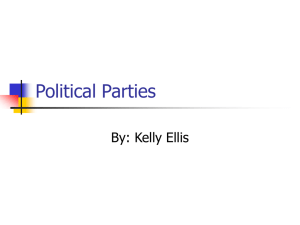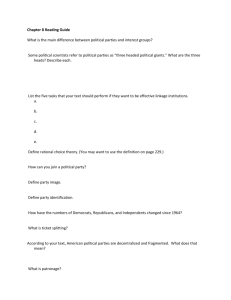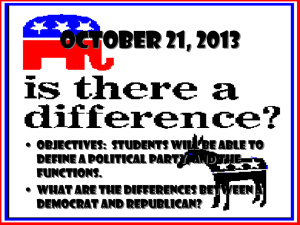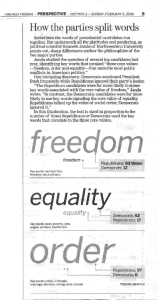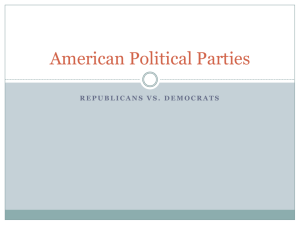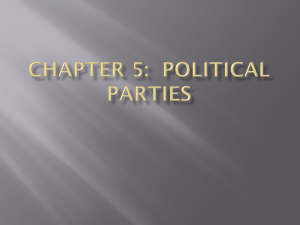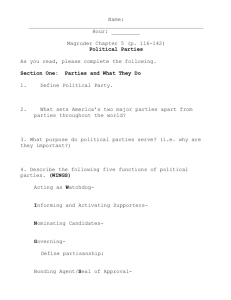Modern American Political Parties
advertisement
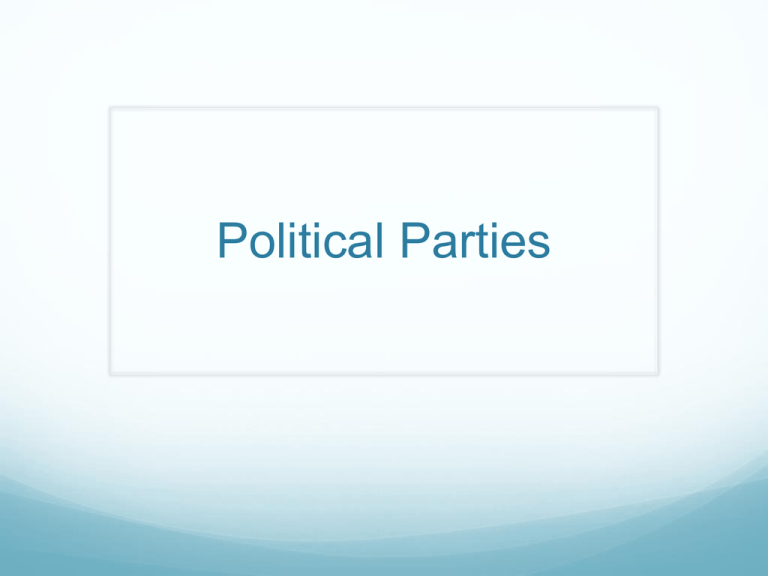
Political Parties Learning Objectives Describe the main characteristics of American parties as: Organizations In government In the electorate Explain the functions that parties perform in the political system Introduction What is the Tea Party and how does it fit into the modern party system 161-162 ? Parties and Party Systems (163-169) What does it mean that American political parties are decentralized 163-164? Example from 2015 Headline: Republican Governors Buck Party Line on Raising Taxes Parties and Party Systems (163-169) What is the difference between the three parts of the party system 164 ? Party Organization Party in government Party in the electorate Parties and Party Systems (163-169) What are the essential details of each of the five party systems? 164-168 First Party System: two factions Hamilton and the Federalists strong national government Implied powers in the constitution Jefferson and the Democratic-Republican Party. limited government Strict Interpretation of constitution Second Party System: Andrew Jackson introduces “mass democracy” Democrats V. Whigs Collapsed over slavery Third Party System: Around the start of the Civil War a time of extreme industrial and economic expansion Party Machines Party coalitions dominated by geography. The South = Democrats who opposed the ending of slavery, North = Republicans, who supported ending slavery. Fourth Party System: Defined by Progressivism, race and immigration. Northeastern business = Republicans South and West = Democrats. Immigrant groups were courted by both parties. Fifth Party System: New Deal Coalition created by FDR in response to the Great Depression. supported new social welfare Made up of under-privileged and minority groups including unions, Catholics, and Jews. Some African-Americans, Sixth Party System: Starts with Civil Rights Act of 1964 Democrats lose their dominance of the South in the late 1960s Republican resurgence with Nixon’s Silent Majority Reading Guide Questions What causes realignment of party systems 168-169 ? What issues (or potential issues) today do you think could drive a realignment? Modern American Political Parties (169-175) What are the important parts and roles of the “Party Organization 169-170 ? What groups outside of the official parties can drive policy Roles of Party in Organization Run day to day operations Recruit candidates and supporters Raise money Work to build consensus Outside Groups Political Action Committees (PACs) or 527 groups Labor unions Interest group Party Brand Names What do you think of when you think Democrats? Positive connotations Negative connotations What do you think of when you think Republicans? Positive connotations Negative connotations Modern American Political Parties (169-175) How does the “Party in Government” work? How is this organized? 171-172 Congressional organization Caucus (congressional) - The organization of Democrats within the House and Senate that meets to discuss and debate the party's positions on various issues in order to reach a consensus and to assign leadership positions Conference- Same thing for Republicans Ideology of Parties in Government (172) Look at the chart on page 172. How does this explain modern partisan conflict? Party in Electorate Look at the graph on page 174. Which party has an advantage in party identification? Party Coalition Look at the charts on page 176 and 177 Who are the Major constituency groups for the democrats? Who are the Major constituency groups for the democrats? Role of Political Parties in American Politics Contesting Elections Cooperation in Government Contesting Elections Recruiting/nominating candidates (through primaries) Campaign assistance Party Platforms Types of Primary's What are the five types of party primaries and what are the differences? Tables on page 178 Presidential Nominations How do parties nominate candidates for president? Party Platforms What are Party platforms? Democrats Republican Cooperation in government Agenda Setting Coordination Coordination Accountability Government can be unified or divided Should Parties Choose Their Candidates? You Decide Page 184 Reading Guide Question What is the role(s) of minor parties in the U.S. political system (183-186)
